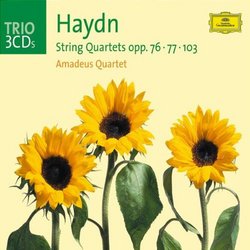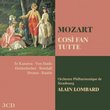| All Artists: Franz Joseph Haydn, Amadeus Quartet, Norbert Brainin, Siegmund Nissel, Peter Schidlof, Martin Lovett Title: String Quartets opp. 76; 77; 103 Members Wishing: 0 Total Copies: 0 Label: Deutsche Grammophon Release Date: 9/10/2002 Genre: Classical Styles: Historical Periods, Classical (c.1770-1830) Number of Discs: 3 SwapaCD Credits: 3 UPC: 028947176220 |
Search - Franz Joseph Haydn, Amadeus Quartet, Norbert Brainin :: String Quartets opp. 76; 77; 103
 | Franz Joseph Haydn, Amadeus Quartet, Norbert Brainin String Quartets opp. 76; 77; 103 Genre: Classical |
Larger Image |
CD DetailsSimilar CDs |
CD ReviewsLovely R. Albin | Ann Arbor, Michigan United States | 12/16/2004 (5 out of 5 stars) "This is an excellent set of the late Haydn quartets. Modestly priced like many reissues of older recordings, this is an audio to digital transfer of recordings made quite a few years ago. The sound quality is not quite as sharp as modern digital recordings but this is more than compensated for by the uniformly excellent level of musicianship exhibited by the Amadeus quartet. This set features some of Haydn's best chamber music, including the famous Emperor quartet with its moving second movement. The playing of the Amadeus Quartet is lyrical and precise, never overplaying the more emotional movements." More essential Haydn quartets jsa | San Diego, CA United States | 07/18/2007 (5 out of 5 stars) "This DGG Trio set of Haydn quartets performed by the Amadeus Quartet complements another Amadeus-Haydn set on DGG very nicely. That set, a specially priced seven disc Collector's Edition box, includes op. 51, 54, 55, 64, 71 & 74. This DGG Trio set includes the six op. 76 quartets plus op. 77 & 103. Between both sets listeners will have some of the best of Haydn's quartets spread over ten discs, authoritatively played by one of Europe's foremost chamber ensembles. The music is of course outstanding with each quartet sounding like a Haydn symphony in miniature. The sonics are excellent (these sides were recorded between 1963-1973) & the 16 pages of liner notes, most of which were written by noted Haydn scholar H.C. Robbins Landon, are illuminating. The price is a great bargain, especially if purchased through one of the Amazon resellers. Most highly recommended!" Most Attractive Readings of Some of Haydn's Greatest Music Doug - Haydn Fan | California | 08/05/2009 (5 out of 5 stars) "Having just listened to some late Haydn played by the very young musicians of the Minetti Quartet it is with some relief to return to this vintage set of the late Haydn quartets played by the Amadeus Quartet. The brash sonorities, deliberate contrasts of chairs, and vivid declamations of modern stylists are largely absent; instead we are treated to smoother sonorities, distinquished string playing, and a consistently cohesive unified whole.
Haydn composed these wonderful works in 1796 and 1797, right after he came back from the second of his tremendously successful trips to England. Rounded, full, and complete, these late quartets feature prominently among classical music's most secure achievements, and for all their boldness of invention and profound slow movements they come across as secure, confident works, rather than very radical groundbreaking music, as they more and more often sound to my ears when essayed by our ambitious young stars of today! Not that I disdain such approaches, merely that modern recordings with their close, highly detailed miking constantly breaks things up, with the players sounding like four individuals, rather than a unified group. (Of course this is merely the other side of the coin - to many today older performances sound too together, too pasteurized, and far too uninterested in bringing out Haydn's inventivness!) The six quartets of Opus 76 revel in every possible combination of string playing, both in solo passages and en masse. Not since Vivaldi had a composer written music so accomplished and experimental as Haydn gives us in his string quartets, and in these late works Haydn showcases ever further inventions and directions. What is most remarkable is how finished it all becomes; Haydn takes the most daring remarkable ideas and makes them perfectly accessible and natural sounding! Opus 76 starts off with a G Major quartet and wastes no time in letting us know Haydn is the ringmaster - the main theme is introduced unaccompanied as if he were writing a fugue - but it's merely a joke on us! With a smirk the movement proceeds into a series of compositional yings and yangs till the recapitulation - where Haydn pulls our leg yet again by deliberately NOT repeating his opening gag as we expect! The second movement turns serious; Haydn now moves beyond even the advanced level of pathos contained within the slow movements of the last six London Symphonies. This is Haydn at his most grave, and Opus 76 in toto encompasses in its slow movements his most complete expression of sorrows and tragedy. The Minuet advances that form firmly along - it is difficult not to call it a scherzo. The Finale is pure Haydn, a dark foreboding quality hangs about until finally a jocular burst of fun breaks out in a conclusion. As it began, so it ends - but along the way we have been blessed with a truly great composer working out even more profound music. By this time, too, Haydn was the past master of counterpoint: The very serious Quartet No. 2 in D minor, nicknamed "The Fifth" for its series of fifths dominating the thematic material, offers up stretto, inversions, a canon, 'cancrizans', augmentation, diminution - 'und so weiter' as the Austrians would put it. The famous "Emperor" quartet, No. 3 in C Major, includes a version of Haydn's "Emperor's Hymn", written in 1797, as the subject for variations in the slow movement. Haydn gives them a display worthy of an Emperor - (But not this one! The Austrian Emperor was the ultimate snob - when it was suggested Haydn should receive the coveted Leopold Medal, given for auspicious public service to the country, the recommendation was set aside till 1814, long after the composer's death, at which time it was denied and signed by the monarch with the notation that Haydn's efforts did not rise to such a level of achievement!) Quartet No. 4 in B flat Major, with the delightful nickname "Sunrise", given for the wondrous opening which conveys the sense of daybreak, holds a wealth of marvels. Following the peacefulness of break of day the first movement bursts out into a passionate counterpart of force and driven rhythms. The slow movement, taken at a nearly dirge-like pace, is worthy of Dido: Haydn touches a deep poignat sense of loss, and offers convincing proof against anyone suggesting Haydn lacked great depths of feeling. The Minuet is a head-spinning whirl of contradictions, made more convulsed by a truly manic Trio. The light, relatively simple finale acts as release for the myriad emotions we've engaged before. One of Haydn's most remarkable works! Quaret No 5 in D Major is dominated by another of these late slow movements, a masterful Largo, full of loss and consolation it carries the listener into the very essence of the composer's personal vision. The last of these six finds Haydn drawing in a bit after such enormous outpourings of feeling, No. 6 in E flat major might be best described as a musician's music, with the composer reverting to playing Prospero with his forces as he runs the soloists through all manner of daring harmonies, so typical of the key. Haydn closes the work with an actual scherzo, although labeled Minuet; it's centered by a trio that's a total joy. Someday someone will give us an entire book on the classical trio - what marvelous lively music abounds within those seemingly simple peasant divertisements breaking out in the midst of the stately minuet! This collection also gives us the two Quartets of Op. 77, and the unfinished single quartet making up Opus 103. The major feature of the Op. 77 quartets is the tremendous expansion of the development, an idea whose time was about explode in the works of Beethoven. The two works, of an anticipated six, as was Haydn's usual fashion now, were all that he finished. Opus 103 is thought to be an attempt to add another to the precious two, but by this time, in 1803, Haydn has exhausted even his seemingly bottomless creative powers, and is only able to finish an Andante and a Minuet. At this point the composer is writing complex music in startling simple ways - having listened to them many times over many years they continue to stand as masterful works which defy categorization. This Amadeus set offers excellent notes, with a consise historical overview covering Haydn's life during the period these works were written, and a short paragraph or two of musical discussion on each of the quartets. Very highly recommended! " |



